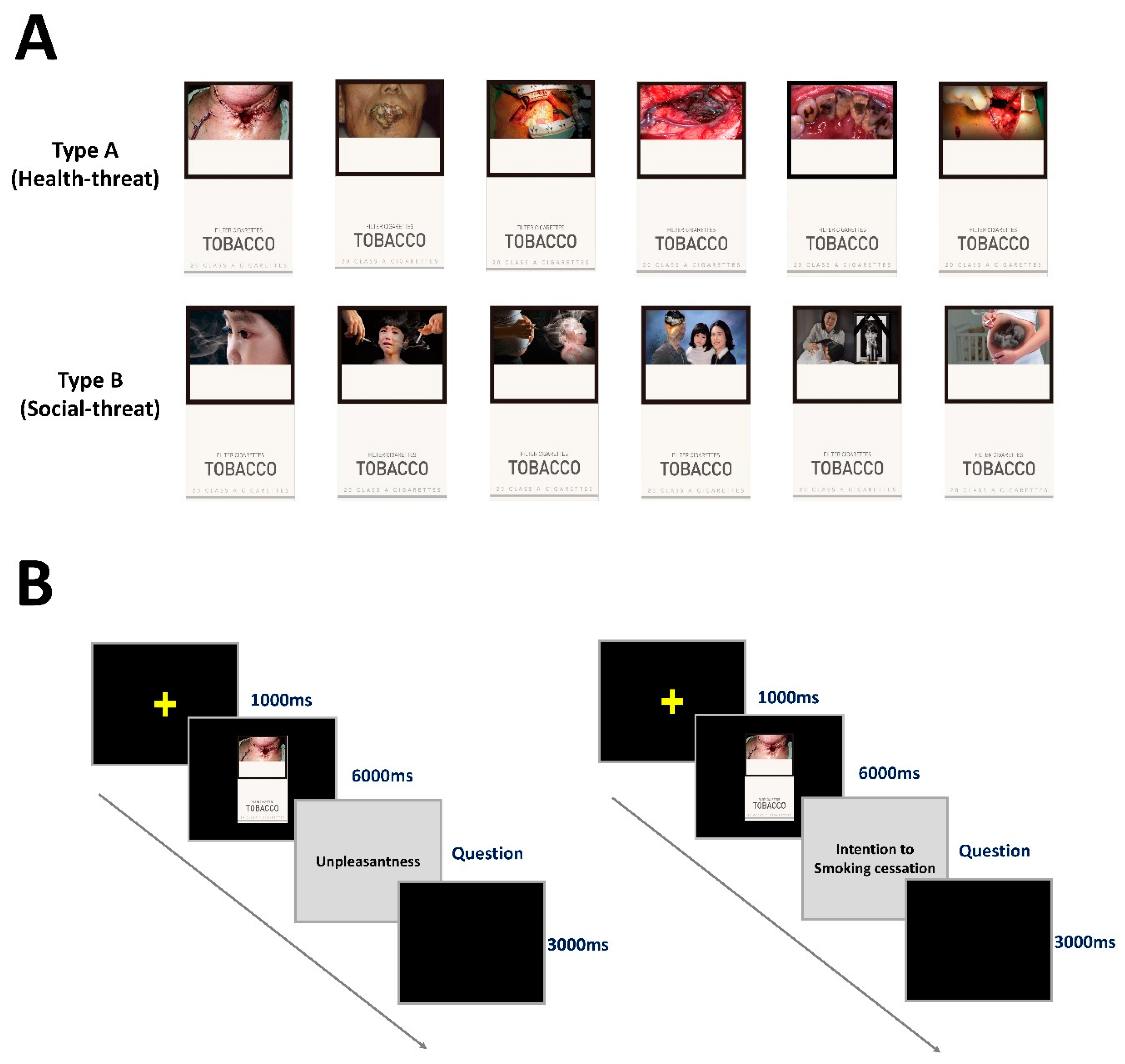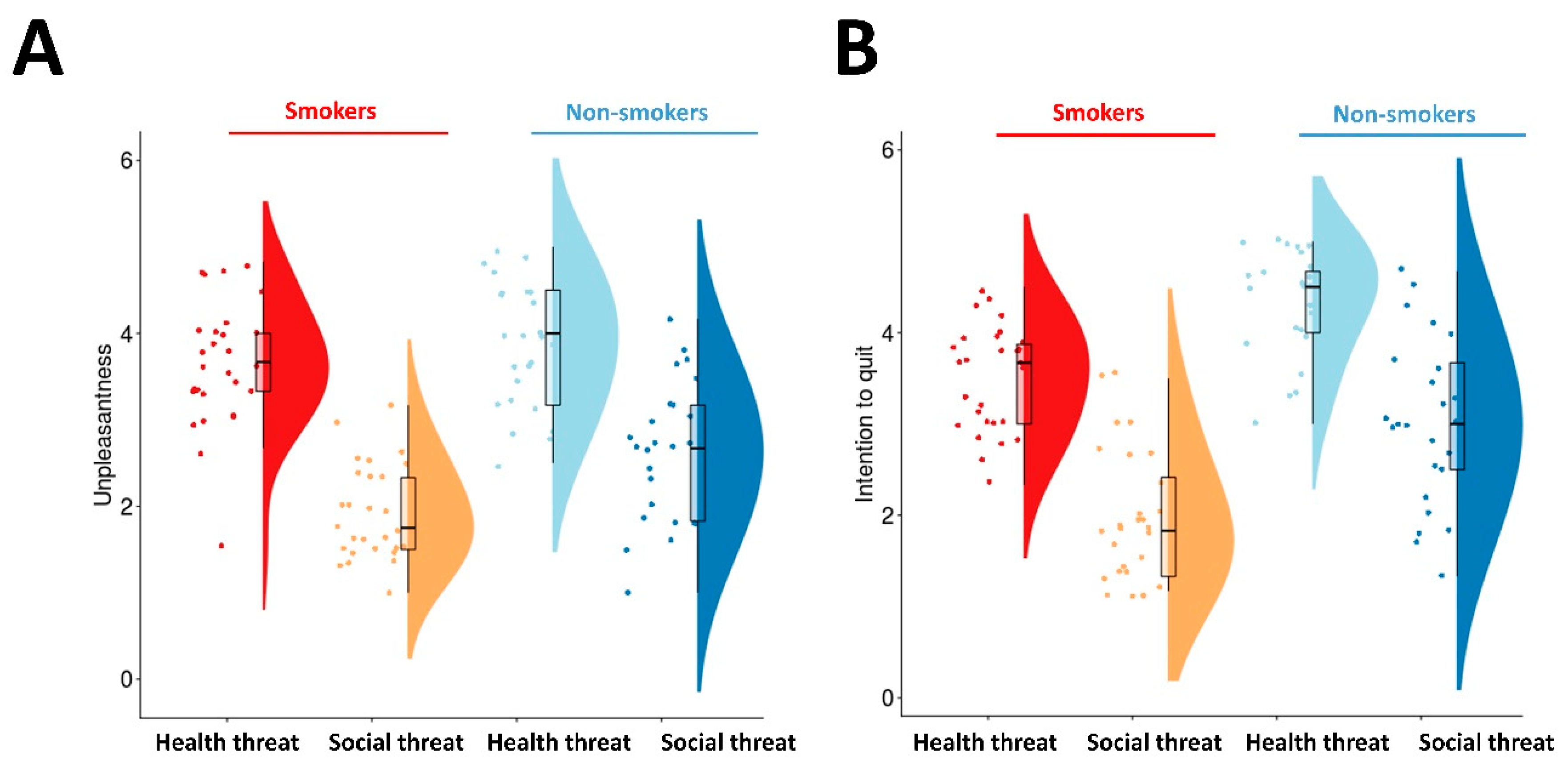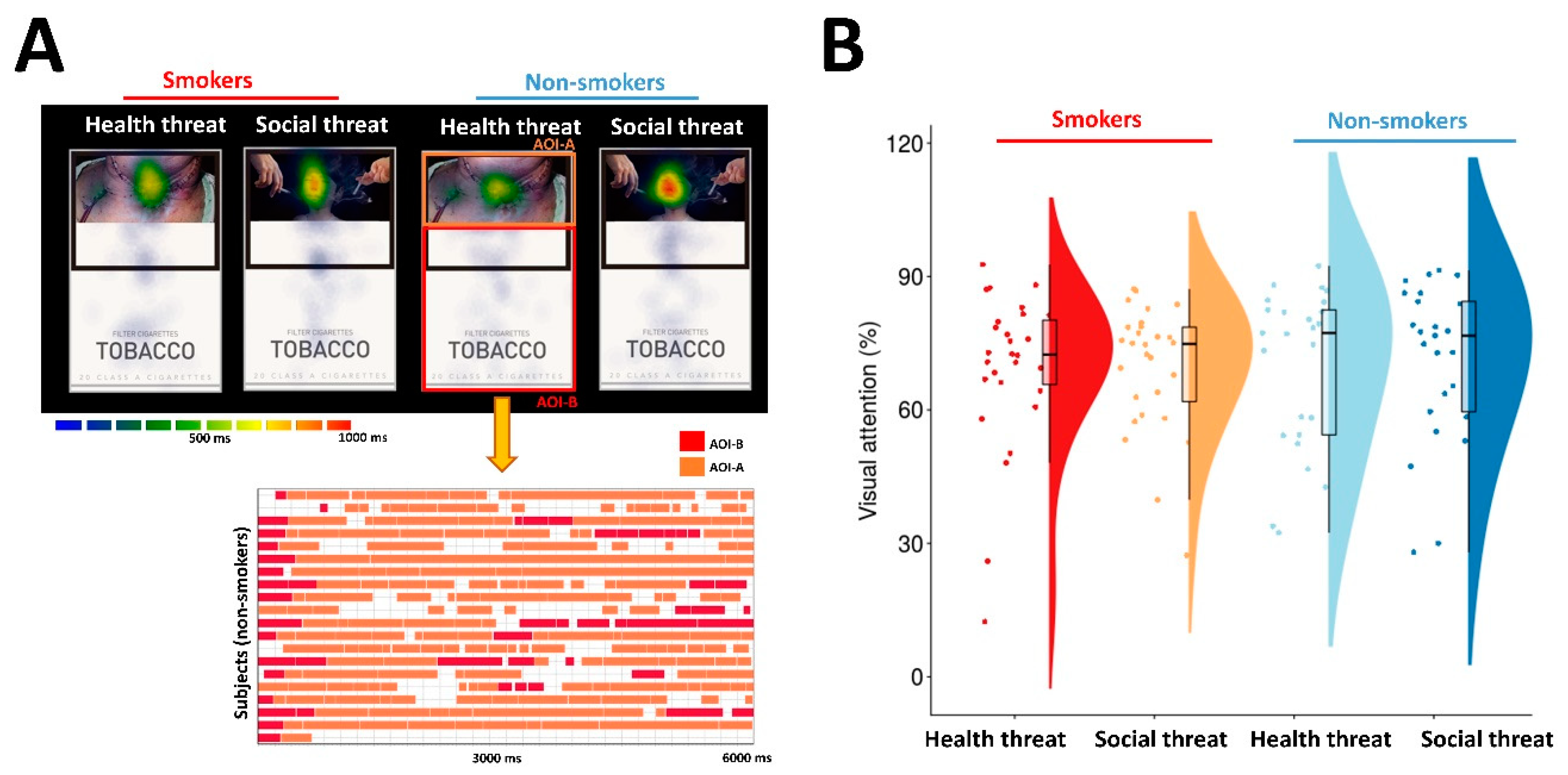Effects of Different Graphic Health Warning Types on the Intention to Quit Smoking
Abstract
1. Introduction
2. Methods
2.1. Participants
2.2. Baseline Characteristics
2.3. Two Types of Graphic Health Warnings on Cigarette Packs
2.4. Psychophysical Assessment
2.5. Eye Movement Measurement
2.6. Data Analyses
3. Results
3.1. Baseline Characteristics
3.2. Psychophysical Rating of Graphic Health Warnings on Cigarette Packs
3.3. Visual Attention to Graphic Health Warning Images
3.4. Multiple Regression Analysis
4. Discussion
5. Conclusions
Author Contributions
Funding
Conflicts of Interest
Data Availability
References
- Jonsdottir, H.L.; Holm, J.E.; Poltavski, D.; Vogeltanz-Holm, N. The role of fear and disgust in predicting the effectiveness of television advertisements that graphically depict the health harms of smoking. Prev. Chronic. Dis. 2014, 11, E218. [Google Scholar] [CrossRef] [PubMed]
- Shen, L. The effectiveness of empathy- versus fear-arousing antismoking PSAs. Health Commun. 2011, 26, 404–415. [Google Scholar] [CrossRef] [PubMed]
- Yoo, J.W.; Jin, Y.J. Comparative impact of fear appeals and induced hypocrisy advertising in encouraging intent to quit smoking: Applying self-construal theory to consumers’ attitudes. Glob. Health Promot. 2020, 27, 51–58. [Google Scholar] [CrossRef] [PubMed]
- Gunter, R.; Szeto, E.; Jeong, S.H.; Suh, S.; Waters, A.J. Cigarette Smoking in South Korea: A Narrative Review. Korean J. Fam. Med. 2020, 41, 3–13. [Google Scholar] [CrossRef]
- Lee, S.G. Assessing impacts of the WHO FCTC on national legislations: A case study of the Republic of Korea. Health Policy 2017, 121, 604–612. [Google Scholar] [CrossRef]
- Hwang, J.E.; Yang, Y.S.; Oh, Y.M.; Lee, S.Y.; Lee, J.E.; Cho, S.I. Differences in visual fixation duration according to the position of graphic health warning labels: An eye-tracking approach. Tob. Induc Dis. 2018, 16, 39. [Google Scholar] [CrossRef]
- Klein, E.G.; Quisenberry, A.J.; Shoben, A.B.; Cooper, S.; Ferketich, A.K.; Berman, M.; Peters, E.; Wewers, M.E. Health Warning Labels for Smokeless Tobacco: The Impact of Graphic Images on Attention, Recall, and Craving. Nicotine Tob. Res. 2017, 19, 1172–1177. [Google Scholar] [CrossRef]
- Andrews, J.C.; Netemeyer, R.G.; Burton, S.; Kees, J. Effects of plain package branding and graphic health warnings on adolescent smokers in the USA, Spain and France. Tob. Control. 2016, 25, e120–e126. [Google Scholar] [CrossRef]
- Hardardottir, A.; Al-Hamdani, M.; Klein, R.; Hurst, A.; Stewart, S.H. The Effect of Cigarette Packaging and Illness Sensitivity on Attention to Graphic Health Warnings: A Controlled Study. Nicotine Tob. Res. 2020. [Google Scholar] [CrossRef] [PubMed]
- Meernik, C.; Jarman, K.; Wright, S.T.; Klein, E.G.; Goldstein, A.O.; Ranney, L. Eye Tracking Outcomes in Tobacco Control Regulation and Communication: A Systematic Review. Tob. Regul. Sci. 2016, 2, 377–403. [Google Scholar] [CrossRef] [PubMed]
- Maynard, O.M.; Attwood, A.; O’Brien, L.; Brooks, S.; Hedge, C.; Leonards, U.; Munafò, M.R. Avoidance of cigarette pack health warnings among regular cigarette smokers. Drug Alcohol Depend. 2014, 136, 170–174. [Google Scholar] [CrossRef] [PubMed]
- Klein, E.G.; Shoben, A.B.; Krygowski, S.; Ferketich, A.; Berman, M.; Peters, E.; Rao, U.; Wewers, M.E. Does Size Impact Attention and Recall of Graphic Health Warnings? Tob. Regul. Sci. 2015, 1, 175–185. [Google Scholar] [CrossRef] [PubMed]
- Peterson, E.B.; Thomsen, S.; Lindsay, G.; John, K. Adolescents’ attention to traditional and graphic tobacco warning labels: an eye-tracking approach. J. Drug Educ. 2010, 40, 227–244. [Google Scholar] [CrossRef] [PubMed]
- Strasser, A.A.; Tang, K.Z.; Romer, D.; Jepson, C.; Cappella, J.N. Graphic warning labels in cigarette advertisements: recall and viewing patterns. Am. J. Prev. Med. 2012, 43, 41–47. [Google Scholar] [CrossRef] [PubMed]
- Kessels, L.T.; Ruiter, R.A. Eye movement responses to health messages on cigarette packages. BMC Public Health 2012, 12, 352. [Google Scholar] [CrossRef] [PubMed]
- Munafo, M.R.; Roberts, N.; Bauld, L.; Leonards, U. Plain packaging increases visual attention to health warnings on cigarette packs in non-smokers and weekly smokers but not daily smokers. Addiction 2011, 106, 1505–1510. [Google Scholar] [CrossRef] [PubMed]
- Koh, K.B.; Park, J.K.; Kim, C.H.; Cho, S. Development of the stress response inventory and its application in clinical practice. Psychosom. Med. 2001, 63, 668–678. [Google Scholar] [CrossRef] [PubMed]
- McNeil, D.W.; Rainwater, A.J. Development of the Fear of Pain Questionnaire--III. J. Behav. Med. 1998, 21, 389–410. [Google Scholar] [CrossRef]
- Olatunji, B.O.; Williams, N.L.; Tolin, D.F.; Abramowitz, J.S.; Sawchuk, C.N.; Lohr, J.M.; Elwood, L.S. The Disgust Scale: item analysis, factor structure, and suggestions for refinement. Psychol. Assess. 2007, 19, 281–297. [Google Scholar] [CrossRef]
- Baron-Cohen, S.; Wheelwright, S. The empathy quotient: an investigation of adults with Asperger syndrome or high functioning autism, and normal sex differences. J. Autism. Dev. Disord. 2004, 34, 163–175. [Google Scholar] [CrossRef]
- Spielberger, C.D.; Gorsuch, R.L.; Lushene, R.E. Manual for the State-Trait Anxiety Inventory (Self Evaluation Questionnaire); Consulting Psychologists Press: Palo Alto, CA, USA, 1970; pp. 1–24. [Google Scholar]
- Toll, B.A.; Katulak, N.A.; McKee, S.A. Investigating the factor structure of the Questionnaire on Smoking Urges-Brief (QSU-Brief). Addict. Behav. 2006, 31, 1231–1239. [Google Scholar] [CrossRef] [PubMed]
- McGuire, W.J. The nature of attitudes and attitude change. In The Handbook of Social Psychology, 2nd ed.; Aronson, E., Lindzey, G., Eds.; Addison-Wesley: Boston, MA, USA, 1969; Volume 3, pp. 136–314. [Google Scholar]
- Stothart, G.; Maynard, O.; Lavis, R.; Munafo, M. Neural correlates of cigarette health warning avoidance among smokers. Drug Alcohol. Depend. 2016, 161, 155–162. [Google Scholar] [CrossRef] [PubMed]
- Lindson, N.; Klemperer, E.; Hong, B.; Ordonez-Mena, J.M.; Aveyard, P. Smoking reduction interventions for smoking cessation. Cochrane Database Syst. Rev. 2019, 9. [Google Scholar] [CrossRef]
- Cook, R.; Davidson, P.; Martin, R.; Centre, N.D. E-cigarettes helped more smokers quit than nicotine replacement therapy. BMJ 2019, 365, l2036. [Google Scholar] [CrossRef] [PubMed]
- Hajek, P.; Phillips-Waller, A.; Przulj, D.; Pesola, F.; Myers Smith, K.; Bisal, N.; Li, J.; Parrott, S.; Sasieni, P.; Dawkins, L.; et al. A Randomized Trial of E-Cigarettes versus Nicotine-Replacement Therapy. N. Engl. J. Med. 2019, 380, 629–637. [Google Scholar] [CrossRef] [PubMed]
- Li, J.; Hajek, P.; Pesola, F.; Wu, Q.; Phillips-Waller, A.; Przulj, D.; Myers Smith, K.; Bisal, N.; Sasieni, P.; Dawkins, L.; et al. Cost-effectiveness of e-cigarettes compared with nicotine replacement therapy in stop smoking services in England (TEC study): A randomized controlled trial. Addiction 2020, 115, 507–517. [Google Scholar] [CrossRef]
- Farsalinos, K. Electronic cigarettes: An aid in smoking cessation, or a new health hazard? Ther. Adv. Respir. Dis. 2018, 12. [Google Scholar] [CrossRef]



| Smokers (n = 28) | Non-Smokers (n = 25) | Significance | |
|---|---|---|---|
| Females, n (%) | 13 (46.4%) | 13 (52.0%) | |
| Age | 22.7 ± 0.5 | 24.0 ± 0.7 | p = 0.141 |
| FTND | 2.9 ± 0.4 | n/a | |
| QSU-Brief | 33.0 ± 1.9 | n/a | |
| SRI | 31.0 ± 4.0 | 26.4 ± 4.4 | p = 0.429 |
| FPQ | 82.3 ± 2.6 | 87.4 ± 3.3 | p = 0.216 |
| DS | 48.5 ± 2.0 | 53.6 ± 2.3 | p = 0.092 |
| EQ | 43.7 ± 2.0 | 41.1 ± 2.2 | p = 0.372 |
| STAI | 41.5 ± 0.9 | 39.0 ± 1.5 | p = 0.309 |
| Smokers | Health Threat | Social Threat | ||||
| Standardized Coefficient (β) | t | Significance | Standardized Coefficient (β) | t | Significance | |
| Constant | 3.028 | 0.007 | −0.532 | 0.601 | ||
| SRI | −0.068 | −0.289 | 0.776 | −0.145 | −0.728 | 0.475 |
| FPQ | 0.086 | 0.364 | 0.720 | 0.232 | 1.165 | 0.258 |
| DS | 0.156 | 0.592 | 0.560 | 0.072 | 0.262 | 0.795 |
| EQ | –0.466 | −1.964 | 0.064 | −0.021 | −0.097 | 0.923 |
| STAI | −0.164 | −0.641 | 0.529 | 0.072 | 0.338 | 0.739 |
| Unpleasantness of GHWs | 0.227 | 1.055 | 0.304 | 0.560 | 2.127 | 0.046 * |
| Attention to GHWs | −0.107 | −0.552 | 0.587 | 0.021 | 0.113 | 0.911 |
| Model fit | R2 = 0.301 | R2 = 0.557 | ||||
| Non-smokers | Health Threat | Social Threat | ||||
| Standardized Coefficient (β) | t | Significance | Standardized Coefficient (β) | t | Significance | |
| Constant | 3.584 | 0.002 | −0.062 | 0.951 | ||
| SRI | −0.087 | –0.351 | 0.730 | 0.070 | 0.214 | 0.833 |
| FPQ | −0.412 | −1.307 | 0.209 | 0.358 | 0.957 | 0.352 |
| DS | −0.189 | −1.021 | 0.322 | −0.154 | −0.444 | 0.663 |
| EQ | −0.068 | −0.247 | 0.808 | −0.008 | −0.032 | 0.975 |
| STAI | 0.263 | 1.118 | 0.279 | 0.085 | 0.270 | 0.790 |
| Unpleasantness to GHWs | 0.622 | 3.074 | 0.007 * | 0.093 | 0.342 | 0.736 |
| Attention to GHWs | −0.442 | −2.107 | 0.050 * | 0.363 | 1.449 | 0.165 |
| Model fit | R2 = 0.487 | |||||
© 2020 by the authors. Licensee MDPI, Basel, Switzerland. This article is an open access article distributed under the terms and conditions of the Creative Commons Attribution (CC BY) license (http://creativecommons.org/licenses/by/4.0/).
Share and Cite
Park, H.; Hong, M.-Y.; Lee, I.-S.; Chae, Y. Effects of Different Graphic Health Warning Types on the Intention to Quit Smoking. Int. J. Environ. Res. Public Health 2020, 17, 3267. https://doi.org/10.3390/ijerph17093267
Park H, Hong M-Y, Lee I-S, Chae Y. Effects of Different Graphic Health Warning Types on the Intention to Quit Smoking. International Journal of Environmental Research and Public Health. 2020; 17(9):3267. https://doi.org/10.3390/ijerph17093267
Chicago/Turabian StylePark, Hyejin, Min-Young Hong, In-Seon Lee, and Younbyoung Chae. 2020. "Effects of Different Graphic Health Warning Types on the Intention to Quit Smoking" International Journal of Environmental Research and Public Health 17, no. 9: 3267. https://doi.org/10.3390/ijerph17093267
APA StylePark, H., Hong, M.-Y., Lee, I.-S., & Chae, Y. (2020). Effects of Different Graphic Health Warning Types on the Intention to Quit Smoking. International Journal of Environmental Research and Public Health, 17(9), 3267. https://doi.org/10.3390/ijerph17093267





